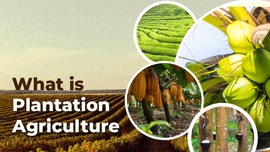What is Zaid Crop Season in India and Which Major Crops Are Grown?

Zaid season is the third most important cropping season in India after Kharif and Rabi. Zaid season is from March to June or before the onset of monsoon season. The crops grown in these months are watermelon, brinjal, muskmelon, cucumber, and many others. In this blog, we will explore the importance of the Zaid crops along with the most required conditions for their growth.
Table of Content
- What is Zaid Crop Season?
- Which are the Popular Zaid Crops in India?
- What is the Importance of Zaid Season in India?
- Required Conditions for the Growth of the Zaid Crops
What is Zaid Crop Season?
Zaid is derived from the Arabic word ‘Zayd”, which means growth. Zaid cropping season, also known as the summer season, occurs during the summer months in the country. It is the period between the two popular seasons in India: Rabi season and Kharif season. The harvesting of Zaid crops is done between the months of March and June. It is the hottest and driest time of the year in the country. The crops grown in this season require less water and can tolerate high temperatures.
Zaid season is ideal for growing a variety of crops, including fruits, pulses, vegetables and oilseeds. The fertile and well-drained soil in the country makes it ideal for producing Zaid crops. Advancements in agricultural technologies, such as high-yield varieties of seeds and fertilizers, enhance crop production during the Zaid season months.
Which are the Popular Zaid Crops in India?
Watermelon, Muskmelon, Cucumber, etc. are the main crops of Zaid season. Let’s deep dive into all the details of the popular Zaid crops grown in the summer season below:
Watermelon
Watermelon is the most popular Zaid crop and a refreshing fruit widely grown and consumed during summer. It requires sandy loam soil rich in organic matter. India is one of the top producers of watermelon in the world. The major watermelon-growing states are Andhra Pradesh, Karnataka, and Uttar Pradesh.
Muskmelon
It is a sweet fruit widely consumed during summer along with watermelon. It requires dry and hot weather. The majority of muskmelon is grown in states like Uttar Pradesh, Haryana, and Rajasthan.
Cucumber
Cucumber is a refreshing vegetable widely used in salads and other dishes. It grows best in warm weather conditions with regular irrigation. India emerges as the largest exporters of cucumber. The popular cucumber-growing states are Uttar Pradesh, Maharashtra, and West Bengal.
Bitter Gourd
It is a healthy vegetable widely used in Indian dishes. It requires well drained soil and high temperature. The majority of bitter ground is grown in states like Uttar Pradesh, Bihar, and West Bengal.
Pumpkin
This versatile vegetable is widely used in India for making soups, curries, and other dishes. It best grows in moist and loamy soil. India is one of the world’s largest producers of pumpkin.
What is the Importance of Zaid Season in India?
Zaid season is the third important crop season in India. Its importance can be concluded with the following points:
- Zaid crops are short-duration crops that can be harvested within 60 to 90 days of planting. Thus, they allow the cultivation of multiple crops in a year, which increases farmers’ income.
- These crops can tolerate high temperatures and hot and dry conditions of summer; thus, they become important in the summer season.
- These crops need less water than Kharif or Rabi crops. Thus, they can be cultivated in areas with limited water availability.
- Zaid crop cultivation helps in enhancing soil health. For example, the cultivation of leguminous pulses and oilseeds can act as soil conditioners.
Required Conditions for the Growth of the Zaid Crops
There are certain points to consider for the success of the Zaid season in India. Let’s have a look at the most required conditions for the growth of the Zaid crops.
- Soil Quality: The soil quality is the most important aspect in the Zaid crops cultivation. The quality of soil must be ideal for the growth of plants. Indian loamy soils are well-drained and fertile, and rich in organic content, which makes them ideal for the growth of Zaid crops.
- Irrigation: Although, Zaid crops does not require a large amount of water, still Irrigation availability is the most important factor during the Zaid season. It helps maintain the soil moisture required for better growth of the crops.
- Seeds Availability: A high-quality seed determines the performance of crops in the Zaid season. Farmers should have access to high-quality seeds for better yield.
- Weather Conditions: Dry weather, temperate conditions and plenty of sunlight are favourable for crop growth in this season. The ideal temperature should be 23°C to 25°C.
- Farming Techniques: The various techniques used in agriculture can impact crop performance during the Zaid season. Farmers need to adopt modern farming techniques such as intercropping, crop rotation, and using organic fertilizers to enhance crop yield.
Frequently Asked Questions On What is Zaid Crop Season in India and Which Major Crops Are Grown?
1. What is Zaid season?
Zaid season is the summer season in which crops are grown for a short period of time.
2. What are the Zaid season months in India?
Zaid season occurs from March to June in India.
3. Which crops are produced during the Zaid season?
Watermelon, muskmelon, cucumber, pumpkin, etc., are some of the crops produced during the Zaid season.


Related Blogs












